Tauba
Auerbach
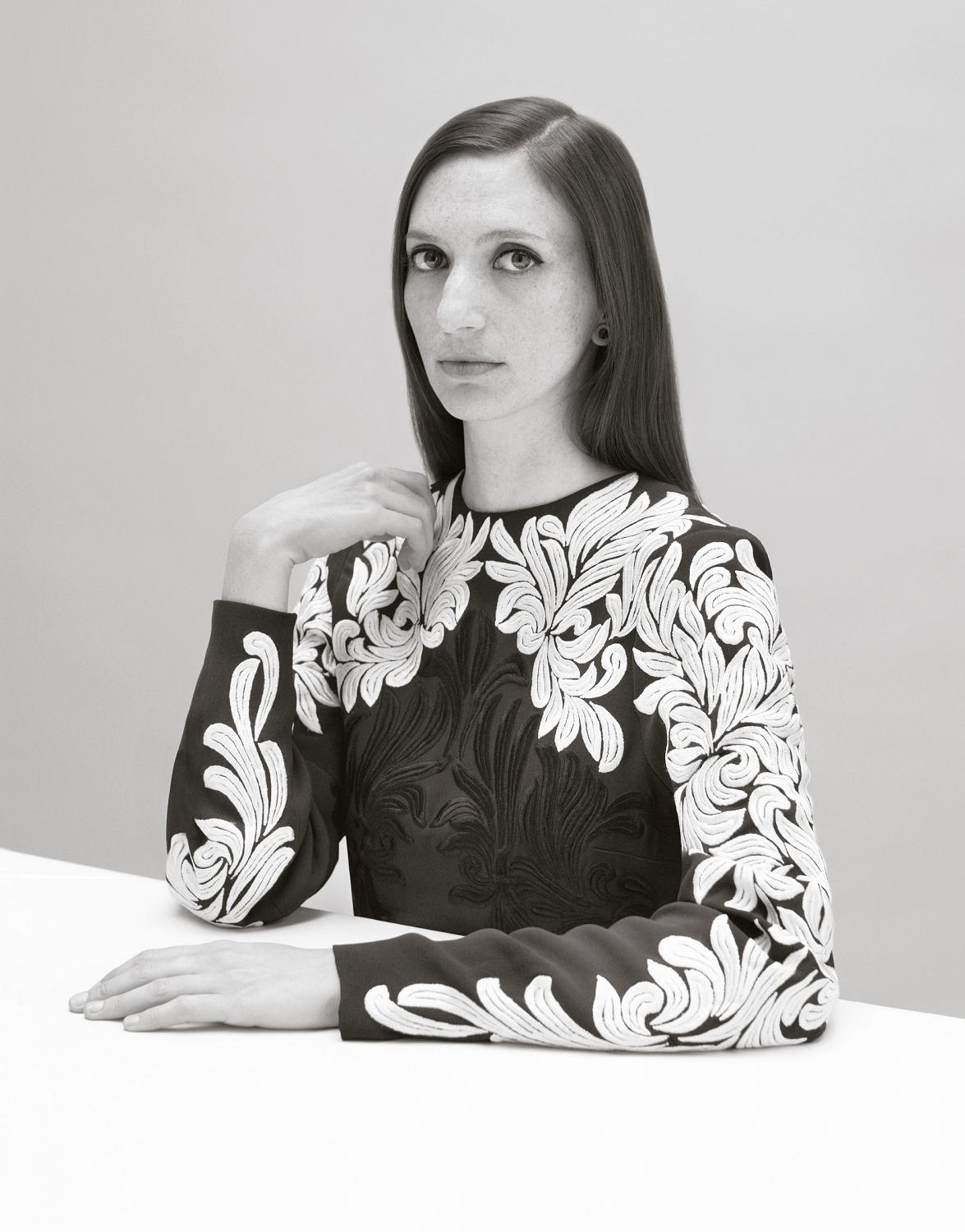
Portraits by Benjamin Alexander Huseby
Styling by Hannes Hetta
Issue n° 6, Autumn & Winter 2012
At 31, the American artist Tauba Auerbach has carved out an intriguing niche for herself in the art world, one that sits somewhere between the fields of science, craft, maths and aesthetics. Her ingeniously analytical work has a manic precision that’s the perfect foil for the languid beauty of Tauba herself. She’s rearranged the Bible into an alphabetical collection of letters, created stunning three-dimensional paintings that turn out to be flat, and Comme des Garçons used one of her playful screen-static abstractions for an ad campaign.
Tauba grew up in San Francisco and now lives in New York, with a studio in Brooklyn and an apartment in Manhattan. But her optimism, she says, still functions on a sunny Californian level. Which is about right for someone who believes in a fourth dimension of colour.
The name at the top of the list of artists on the website for Paula Cooper’s New York gallery is that of Carl Andre, one of the most famous living artists in the world. And just underneath it is Tauba Auerbach’s. Andre, known for minimalist floor arrangements of bricks and metal plates that confounded and enraged the general public in the 1960s, was born in 1935. Auerbach was born in 1981.
It’s no wonder, then, that she was getting a little nervous as she set up her latest show in May in Cooper’s Chelsea space, where Andre too has displayed his work. “They don’t look right,” she said skittishly of the Fold paintings – two-dimensional works in acrylic that look exactly like three-dimensional crumpled paper – that she was hanging on the white walls. “Are they too high or far apart, or not enough...” She trailed off, sounding anxious and tired, her enormous dark eyes getting bigger with despair. Motionless, with her long dark hair tied into a ponytail and her hands on her skinny hips, she looked like an angular marionette whose master had momentarily forgotten to move the strings.
Tauba and I had tried to meet the night before. “I’m in the hall outside the show, I’m wearing gold shoes,” read her text, sent from New York’s Museum of Modern Art, where the opening party for Ecstatic Alphabets/Heaps of Language – a group show of work by artists, designers and poets who’ve used words and letters beyond their usual function – was in full force. An impressive number of Tauba’s Anagram series of alphabetical re- and deconstructions was on view. In some, phrases are spelt out in colourful capitals; in others, letters are laid over each other to create bright zinging patterns. “On my way, zebra-print ponyskin,” read my reply.
Neither of us had really reckoned on the number of guests who attend a MoMA vernissage; even our spiffy shoes didn’t stand out enough in the circumstances. It was a needle-in-a-haystack situation (as we commented in text exchange number three), and we never found each other. Tauba did meet Liliane Lijn, though, a smiley redhead who was the first woman to work with kinetic text and whose two pieces in the show, a rotating barrel shape and cone shape, were in pole position at the entrance. “She was wonderful – we had so much in common and so much to talk about,” Tauba says when we finally catch up on the phone several weeks later (our meeting in the Paula Cooper Gallery had been understandably brief). “I’d guess she’s in her 60s, but she seems about 30 in spirit. I’m really preoccupied with examples of how I want to be as an older person. There are a lot of really negative examples out there, so I’m really thrilled when I meet someone who’s older and has the kind of attitude that I hope to have in my late 60s.” (Liliane, it turns out, is a surprising 73.)
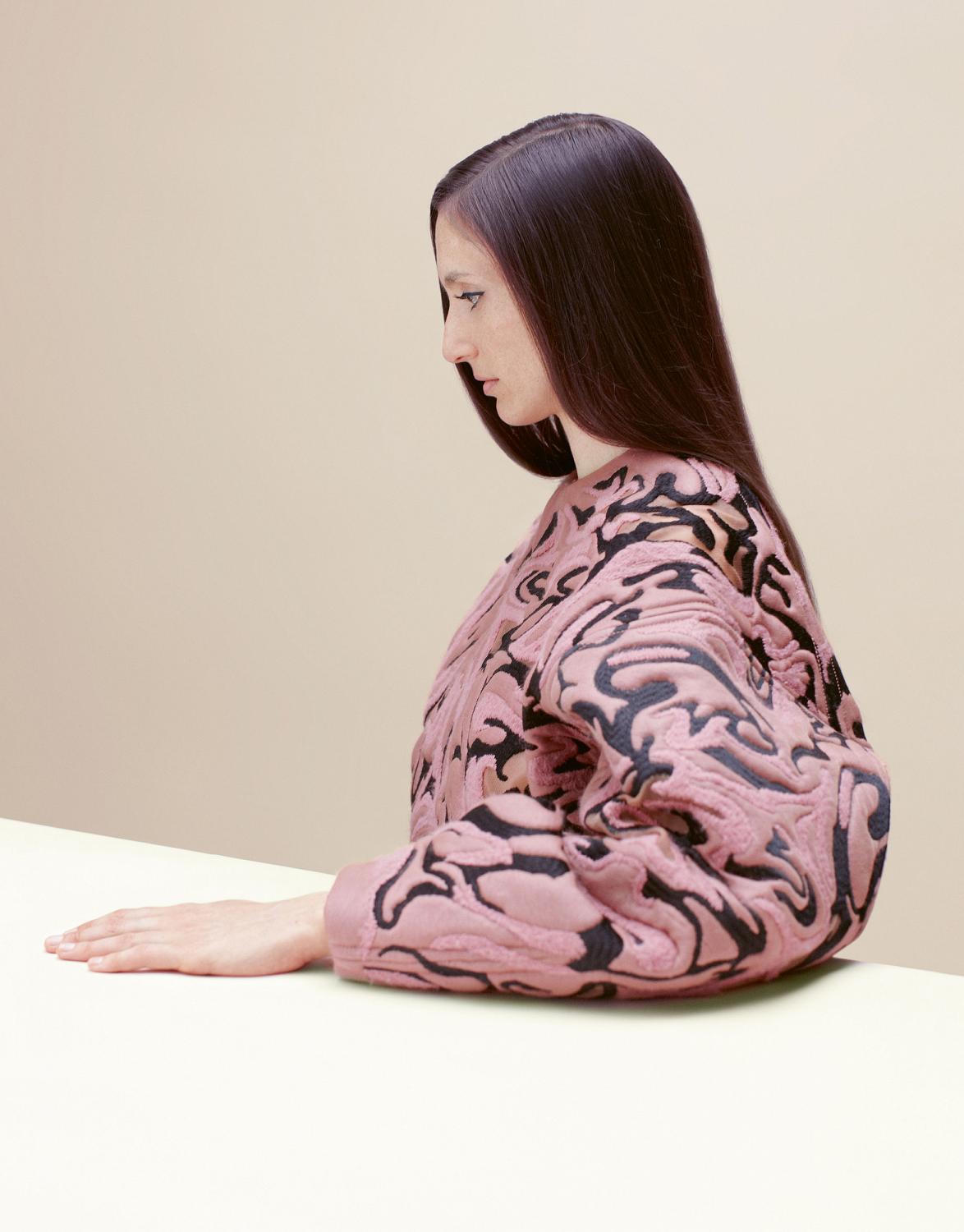
Tauba has a keen eye for pattern. Here, she is wearing a pink-and-black embroidered moiré sweater by BALENCIAGA. In the opening image, she wears an embroidered top by STELLA McCARTNEY.
It’s funny that someone who’s had success so young is already preoccupied with being old. But then Tauba’s mind seems able to be preoccupied with many things at once. Her work since her graduation in fine art from Stanford University in 2003 has travelled from the aforementioned de- and reconstructions of type through op-art dot paintings and fields of black and white triangles and dashes. She’s taken images of static from the television screen and turned them into plains of mesmeric dots. She’s produced books that function as sculptures and the Fold paintings that mimic crumpled paper. She’s worked in cast resin and broken glass. And most recently, she’s created subtly three-dimensional canvases out of, well, woven canvas – the bedrock of the painter’s craft. “I wanted to see if I could pick apart this neutral, unpigmented white canvas and make movement and dimension happen in a monochromatic field,” says Tauba, whose work is always as spatial and scientific as it is pleasing to behold. “The woven pieces are essentially two complete planes that are constantly changing places.”
Tauba herself is very neat, and so are her work and her thinking. “Ms. Auerbach, operating in the gap between conceptual art, abstraction and graphic art, still manages to give didacticism a good name,” said the powerhouse New York Times critic Roberta Smith, describing Tauba’s extraordinary treatment of the Bible, in which she rearranged the letters in each word alphabetically. (The full title The Holy Bible comes out as Bbe ehHi lloTy.) The conceit behind it is that any piece of writing, regardless of its content or intellectual intention, is only ever a collection of letters that have been particularly arranged. Her point is beautifully proven.
“I’m not interested in people who buy art just because it’s what they think rich people should do.”
Aside from all this, Tauba has found time to collaborate with the Microsoft researcher Byron Cook to create nine new mathematical symbols to represent functions not easily described by existing notations. She made a collection of jewellery for Ohne Titel in 2010 from clear acrylic and elastic cord; the pieces looked like the innards of machinery recreated in Lucite and bright colours.
In 2009, she designed a pump organ with her best friend, Cameron Mesirow of the band Glasser. It’s called Auerglass, and the two play it together dressed in identical blue dresses and shoes with immense wooden wedges designed by their friend Ida Falck Øien. It can’t be played alone.
“Cameron and I were living together in San Francisco for four years,” says Tauba. “We were the kind of roommates who would just do everything together, and one night we were bored and made this really crappy banjo out of a cookie tin, and I mean, it was bad – it had three strings that we took off someone else’s guitar. Then we thought, Let’s do something more ambitious, something impossible for just one of us to play, like a love song to our friendship.” The resulting instrument was constructed for the pair by kindly organ specialists in upstate New York, who were transfixed by the idea, and presumably by the sweetness and enthusiasm that practically seems to seep from Tauba’s pores.
It would be intriguing to know just how much the Auerglass might now be worth. (It premiered at Tauba’s 2009 show Here and Now/And Nowhere at Deitch Projects in New York; the girls performed a specially devised piece of music 33 times during the exhibition’s run.) In March this year, a 2006 black- and-white Auerbach deconstruction of zeros and ones into op-art dashes called ‘Binary Lowercase’ went under the hammer at Phillips de Pury in New York for $86,000. Its estimate was $40,000–$60,000. At the Paula Cooper show in May, every piece sold for between $20,000 and $60,000.
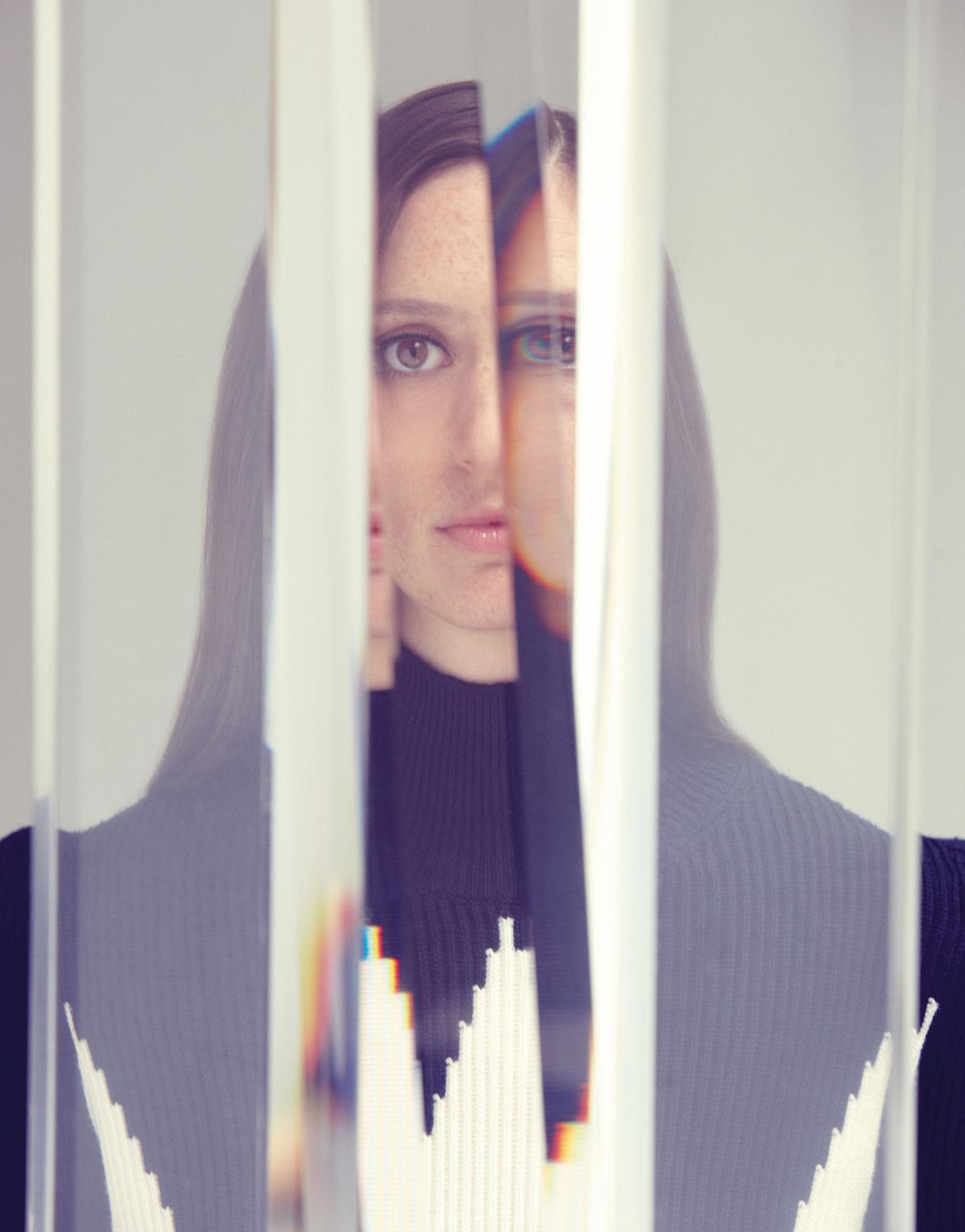
Tauba’s wearing a knitted sweater by STELLA McCARTNEY.
“It must be scary for her,” says Valeria Napoleone, a prominent London collector, who owns an Anagram piece called ‘Creation Reaction’ and visited Tauba in her neat, tidy Brooklyn studio four years ago. “I don’t know how many hours I stayed there. We talked about fashion, art, postcards, mass-market culture, performance. She’s a very 360-degree person, not a painter or a sculptor but something more. You can’t put her into a box; she creates her own language.”
During and after Stanford, Tauba worked for a signwriting company in San Francisco called New Bohemia Signs, which she’d pass every day on her bike. “I was always so enamoured with all these beautiful hand-lettered signs in the window – some of them had gold leaf – so I cold-called them, and the apprentice that was there was about to leave,” she says. She stayed three years, and it’s not hard to see how this intense interaction with type has fed into her subsequent work. Aged 23, she had her first show, of the text-based work that featured in the MoMA exhibition, at Los Angeles’ New Image Art Gallery. Some of her collectors date from that time. “I got a nice review in the LA Times,” she recalls brightly.
In 2008, she moved to New York with her then boyfriend, the artist Keegan McHargue, a brilliant colourist who paints, draws and sculpts. They had copies of each others’ freckles tattooed onto their hands, and though they split up, they’ve stayed close friends.
She met her current boyfriend – or, as she calls him, “sweetheart” – Chris Jennings in a Lower East Side dive called Home Sweet Home, a stamping ground for edgy Nolita kids who like taxidermy. That was a couple of years ago. He’s a writer, halfway through a book on early American utopian communities. He lives in Brooklyn, while Tauba lives in Manhattan. “I don’t plan to ever get married,” she says. “So moving in together is a bigger deal for me than it is for most people, I think.”
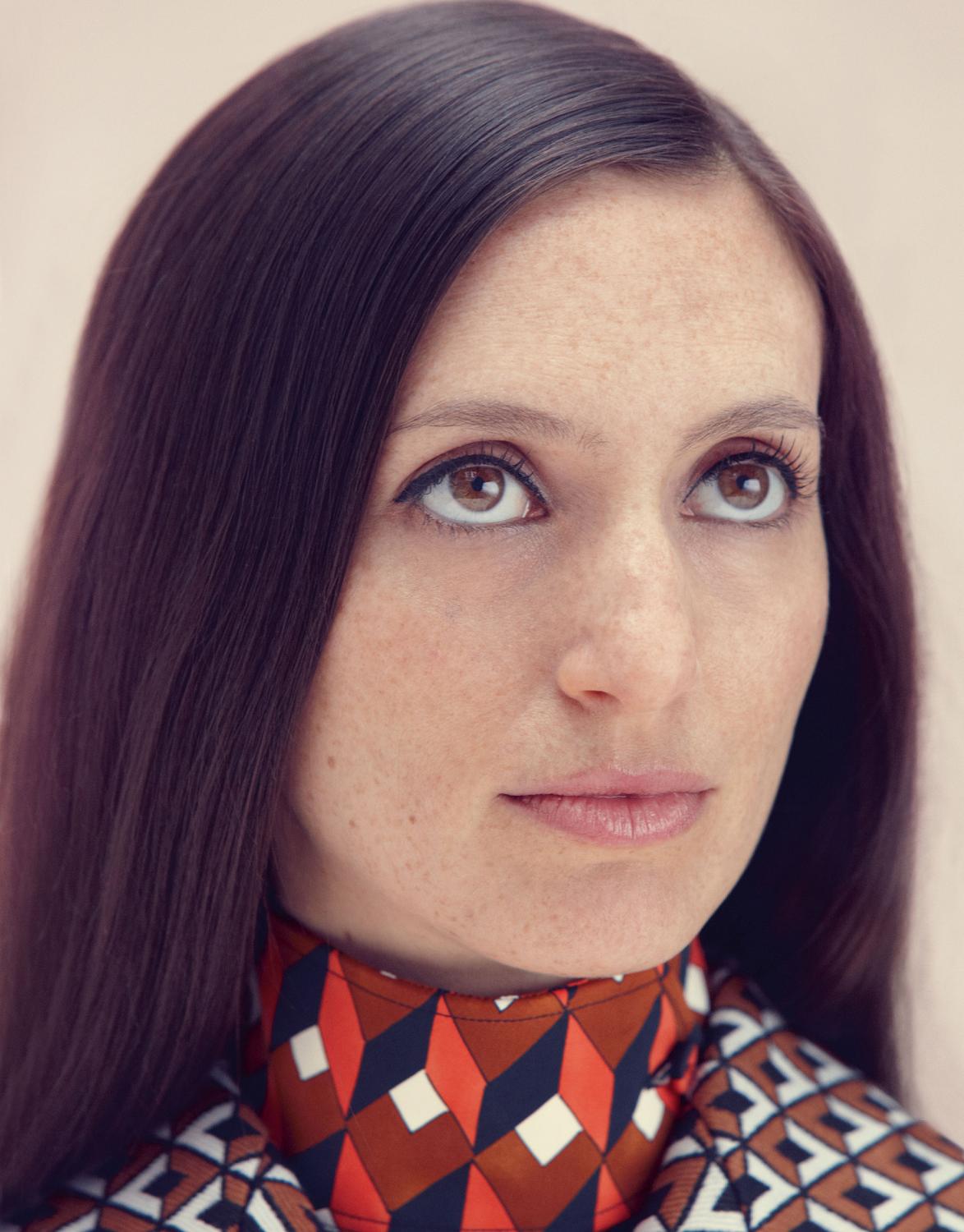
Here, Tauba is wearing a multicoloured shirt and jacket by PRADA.
Not that she’s been put off marriage, exactly. Her parents are still together aged 70 (him) and 68 (her); a creative couple, they run a theatre consulting company. “They design the mechanisms – hydraulics, lighting systems, the sight lines of the seats,” Tauba says. They most often work for theatres and opera houses but sometimes branch out to a planetarium or place of worship.
As an only child, Tauba got plenty of art projects to do. “I think it definitely had a key role in forming me,” she muses now. “I had to amuse myself for long stretches of time, so I have a long attention span. I can focus on one thing for a really long time, and maybe that wouldn’t have been true if I had had a sibling around.” Her friend Cameron is also an only child. “She feels like a member of my family, and interestingly enough, sometimes people who don’t even know us just know we’re connected or think we’re sisters.” Cameron is as angular as Tauba but blonder, with a big Californian smile.
Perhaps the other factor that most informs Tauba is her San Francisco upbringing. “There are a number of artists – female, from San Francisco, like Carol Bove and Trisha Donnelly – who share a sensibility,” says Laura Hoptman, the curator of MoMA’s Ecstatic Alphabets/Heaps of Language. “Tauba is ten years younger, but they’ve all benefited from being somewhere with an innate sense of freedom. The city is still attached to the utopian ideas of the 1960s and 1970s. They’re happy with the idea of experimentation.”
In 2009, Tauba was taken on by Jeffrey Deitch, then a major force on the New York art scene. When he left town for LA in 2010, the other gallerists pounced (by then Tauba had also appeared in the Whitney Biennial). “I went through a difficult year figuring out what to do,” she says. “I’m naturally a pretty open person, and I expect people to be genuine with me. I was meeting a lot of people all at once, and I realised this decision was going to be hard to make and that other people aren’t always so genuine.”
She finally settled on Paula Cooper, a low-key but phenomenally important gallerist who’s been active since 1968 and dresses in grey cashmere separates, speaks quietly, and thinks intellectual content first and money second. Apart from Andre, Cooper numbers Sol LeWitt, Sherrie Levine, Christian Marclay and Paul Pfeiffer among her charges. “I think of her as a sage,” says Tauba. “She’s wise and thoughtful and never fake.” Tauba’s collectors must have breathed a collective sigh of relief.
“I’ve been moving in a straight line and now I just want to be able to move diagonally.”
To an extent, Cooper is protecting Tauba from the vicissitudes of the art world, of which the artist is rightly wary. “I’m not interested in people who buy art just because it’s what they think rich people should do,” says Tauba. In fact, her favourite collectors are those connected to her other gallery, Standard (Oslo) in the Norwegian capital. “They’re just very interesting people,” she says. “There’s a conductor, and a Beckett scholar, and a mountain climber-slash-psychologist. They’re smart people. I feel like they’re having some kind of cerebral engagement with the art that they’re purchasing.”
The temptation for many artists would be to keep the hits coming. Tauba could surely churn out Fold paintings for the rest of her life and make an exceptionally comfortable living. “But I’m so interested in just too many things,” she says, “and I don’t know how I’ll ever be able to absorb all of the information that I want to in my life. Now I have the luxury of being able to step back. I’ve decided to take roughly a year for myself and – the way I’m articulating this in my mind, I’ve been moving in a straight line, and now I just want to be able to move diagonally.”
Her diagonal moves will include a collaboration with the British choreographer Wayne McGregor at the Royal Opera House for 2014 and a couple of months’ stint this year at the Smithsonian Institution Washington DC. There, as the beneficiary of an artist research scholarship, she’ll delve further into her obsession with tetrachromacy: the possibility of a fourth colour beyond the red-blue-green spectrum.
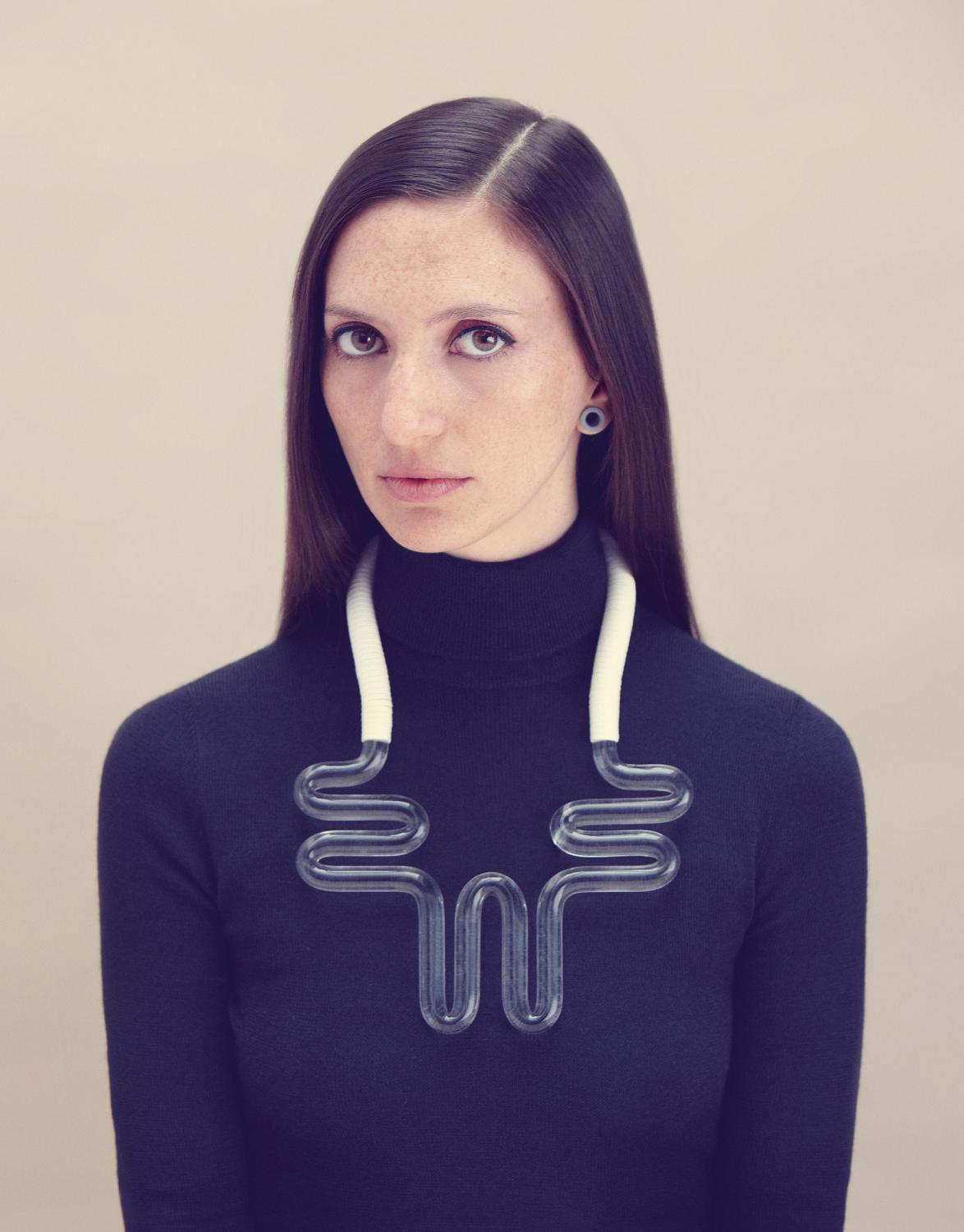
Tauba made this transparent acrylic-and-enamel cord necklace the night before this photoshoot. The black turtleneck is by DIOR.
Having explored the idea of a fourth spatial dimension in her work for years, Tauba took a collection of new pieces focusing on colour, Tetrochromat, to Norway’s Bergen Kunsthall last November. The show was epic and included a 1,670-page book vividly hand-sprayed with thousands of colours from the trichromatic system (there are 16.7 million in all). It was a starting point from which to head into the next colour dimension, which is only potentially available to women (it’s genetically fixed to the X chromosome).
“I guess one of the biggest shifts I had in my thinking, in my work process, was that I stopped conceiving of higher spatial dimensions as ‘beyond’,” Tauba says, “and started thinking that these higher dimensions might in fact be sort of coiled up within our space. This is up for debate, but it’s an interesting and different way to think about it. Similarly with tetrachromacy, the fourth colour receptor would likely be between the red and green range, say – not outside of our spectrum but within it.” Let’s hope Jennifer Giaccai and Katherine Ott, the conservation scientist and curator/historian the Smithsonian’s matched her with, aren’t expecting a fluffy artist to walk through their doors. She might wear a grey cashmere Fendi cape, but she’s no such thing.
Tauba will spend two months in DC and then return to New York. Occasionally she imagines going back to San Francisco, “because I really miss being able to cook with fresh vegetables all the time…the quality of the produce,” she sighs. “It’s a much warmer, more forgiving place, and I just keep making friends with people from California because I’m wired that way. But at the same time, it’s so complacent; it’s almost too comfortable there. There isn’t a sense of people really challenging themselves or each other as much as there is in New York.” She takes a sip of water and makes a little humming sound. “I really like to feel like my surroundings are pushing me to be a better version of myself,” she says – though many would agree the current version is quite good enough already.
Caroline RouxScan the masthead of any significant publication today and you’re guaranteed to find Caroline Roux. Her colourful career in journalism has seen her inside many of the industry’s best newsrooms, from the Financial Times to the Telegraph, and also The Gentlewoman’s offices. She’s also a dab hand…read more Portraits by
Benjamin Alexander HusebyThe photographer Benjamin Alexander Huseby hails from Norway. He studied at the Chelsea of School of Art, London and currently lives in Berlin. Benjamin is a contributor to magazines such as Fantastic Man, Self-Service, both UK and US editions of Vogue, BUTT, Dazed and i-D and his work has featured in…read more Styling by
Hannes HettaSwedish stylist Hannes Hetta is a contributing fashion editor to The Gentlewoman and one seriously in-demand man. Just some of the publications to feature his many contributions are Fantastic Man, Hercules, i-D, T: The New York Times Style Magazine and Vogue Hommes International. Hannes also consults…read more
Hair: Rudi Lewis. Make-up: Aya Komatsu. Photographic assistance: Hector de Jesus. Styling assistance: Ashley Christopher. Digital operation: Justin Schaffer. Production: George Miscamble at REP Limited. Thanks to the Paula Cooper Gallery.
This profile was originally published in The Gentlewoman n° 6, Autumn & Winter 2012.